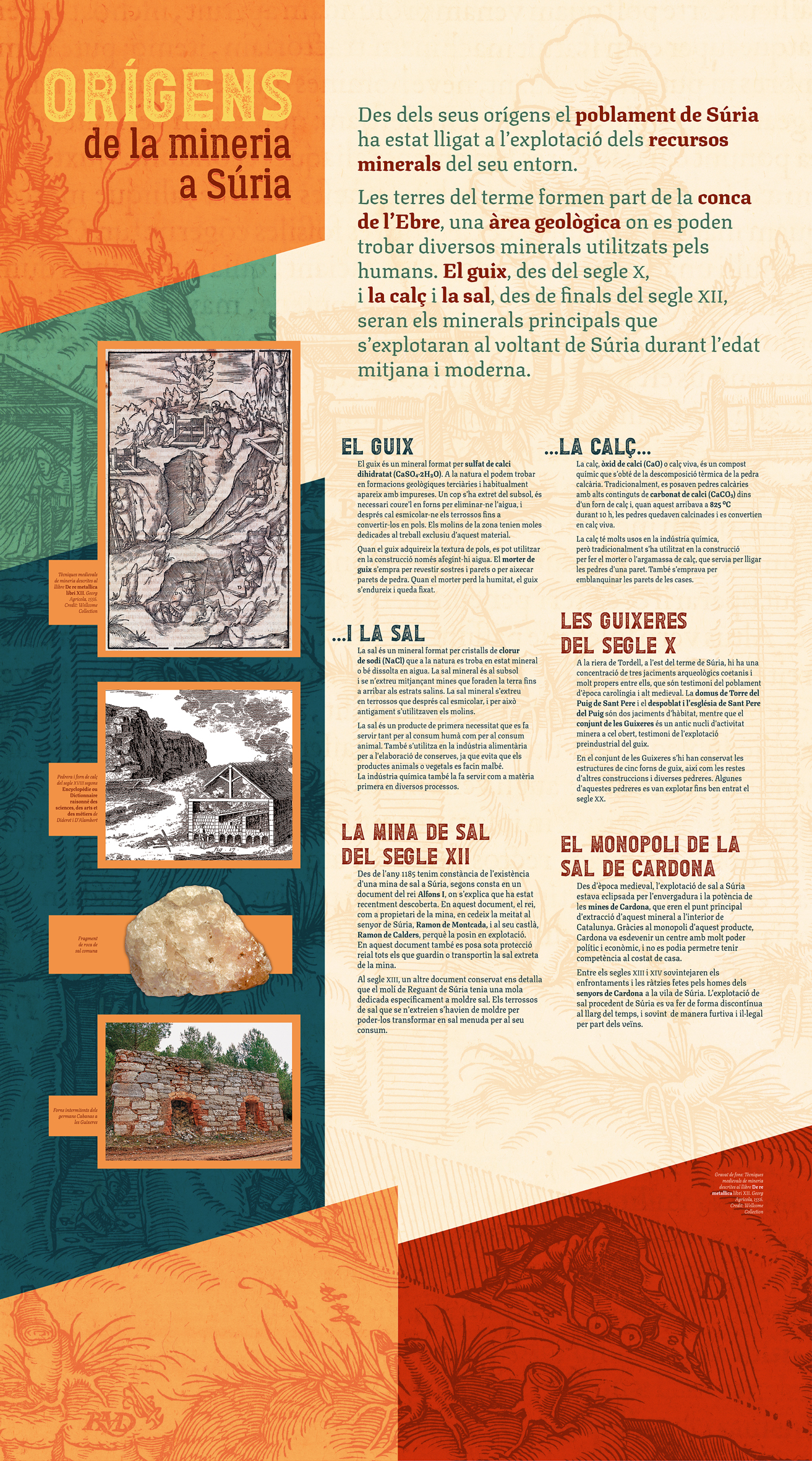1. MINING IN SÚRIA THROUGHOUT HISTORY
From its origins, the population of Súria has been linked to the exploitation of the mineral resources of its surroundings.
These lands are part of the Ebro basin, a geological area where various minerals used by humans can be found. Gypsum, from the 10th century, and lime and salt, from the end of the 12th century, will be the main minerals that be exploited around Súria during the Middle and Modern Ages.
GYPSUM
Gypsum is a mineral formed by calcium sulfate dihydrate (CaSO4·2H2O). In nature, we can find it in tertiary geological formations, and it usually appears with impurities. Once it has been extracted from the subsoil, it is necessary to bake it in ovens to remove the water, and then the clods must be crushed to powder. The mills in the area had grinding wheels dedicated to the exclusive work of this material.
When the gypsum acquires the texture of powder it can be used in construction, just by adding water. Gypsum mortar is used to coat ceilings and walls or to erect stone walls. When the mortar loses moisture, the gypsum hardens and sets.
LIME
Lime, calcium oxide (CaO), or quicklime is a chemical compound obtained from the thermal decomposition of limestone. Limestones with high calcium carbonate (CaCO3) contents were traditionally placed in a lime kiln, and when it reached 825ºC for 10 hours, the stones were calcined and turned into quicklime.
Lime has many uses in the chemical industry, but traditionally it has been used in construction, to make the mortar or lime mortar, which was used to bind the stones of a wall. It was also used to whitewash the walls of houses.
...AND SALT
Salt is a mineral formed by crystals of sodium chloride (NaCl), which in nature is found in a mineral state or dissolved in water. Mineral salt is found in the subsoil and is extracted using mines that drill the earth until reaching the salt strata. The mineral salt is extracted in clods which will then have to be crushed, which is why mills were used in the past.
Salt is a basic necessity product that is used for both human and animal consumption. It is also used in the food industry for the preparation of preserves, as it prevents animal or vegetable products from spoiling. The chemical industry also uses it as a raw material in various processes.
THE QUARRIES OF THE 10th CENTURY
In the Tordell stream, at the east of Súria, there is a concentration of three archaeological sites of the same age and very close to each other, which bear witness to the settlement of the Carolingian and early medieval periods. The Domus de Torre del Puig de Sant Pere and the depopulated area and the church of Sant Pere del Puig, are two habitat sites, while the Guixeres complex, is an old centre of open pit mining activity, witness of the pre-industrial exploitation of gypsum.
The structures of five gypsum kilns, as well as the remains of other constructions and several quarries, have been preserved in the Guixeres complex. Some of these quarries were in operation well into the 20th century.
THE 12th CENTURY SALT MINE
Since 1185 we have evidence of the existence of a salt mine in Súria, according to a document of King Alfonso I, which explains its recent discovery. In this document, the king, as owner of the mine, cedes half of it to the lord of Súria, Ramon de Montcada and his castellan Ramon de Calders, so that they can put it into operation. In this document, all those who keep or transport the salt extracted from the mine are also placed under royal protection.
In the 13th century, another preserved document tells us that the Reguant de Súria mill had a grinding wheel specifically dedicated to grinding salt. The clods of salt that were extracted needed to be milled to transform them into fine salt for consumption.
CARDONA'S SALT STATE-RUN MONOPOLY
Since medieval times, the exploitation of salt in Súria was overshadowed by the scale and power of the Cardona mines, which were the main point of extraction of this mineral in the interior of Catalonia. Thanks to the monopoly of this product, Cardona became a centre with a lot of political and economic power and could not afford to have competition close to home.
Between the 13th and 14th centuries, there were frequent confrontations and raids by the men of the Lords of Cardona in the town of Súria. The exploitation of salt from Súria was done discontinuously over time, and often its extraction was done furtively and illegally, by the neighbors.


